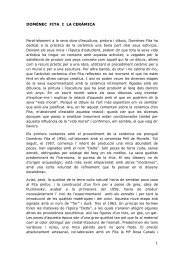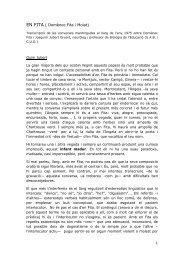Fita ART INTEGRAT, 2005. - Fundació Fita
Fita ART INTEGRAT, 2005. - Fundació Fita
Fita ART INTEGRAT, 2005. - Fundació Fita
You also want an ePaper? Increase the reach of your titles
YUMPU automatically turns print PDFs into web optimized ePapers that Google loves.
INTRODUCTION<br />
We cannot underestimate the importance of<br />
an artistic medium as common as integrated art<br />
is. It is very true it lives different vicissitudes<br />
from the types of art which we can call exhibition<br />
art, but not for this does it have any less importance.<br />
These types of expression have left large<br />
quantities of works to communities, cities and<br />
museums all around the world, as the most priceless<br />
witness to the fact that today we still admire<br />
it and live history has been stamped on places<br />
and international culture.<br />
This art, so linked to the social life of the communities,<br />
is usually the work of artists and craftworkers<br />
working as a group. This is still produced<br />
nowadays and institutional support would be<br />
necessary to give it full and vital continuity<br />
which would help to show its worth, as also the<br />
proper love and conservation as a phenomenon<br />
of the great collective importance it has.<br />
The affection and enthusiasm I felt for orientating<br />
artistic learning had as a common objective<br />
the fulfillment, in the future, of works like<br />
those to be found in public places: streets, churches....<br />
in spaces where were produced deliberately<br />
works to order or integrated art, suitable<br />
works for each place or specific atmosphere,<br />
integration with the architecture, in the urban<br />
space. To sum up, the objective was to make a<br />
more social art, of public communication and<br />
also private.<br />
Without doubt, in the conviction of my argument<br />
I may have been influenced also by the fact<br />
that when little short of 9 years old, I already felt<br />
a love for those skills which I lived near to, of<br />
which I still remember the smells and the feel of<br />
the tools, the plastic of each one, and also that<br />
during the years 1939/40, when I was only 12<br />
years old, I had a master, the first best, Mr<br />
Carrera. He was doing some reliefs for the new<br />
bridge Pont Major, in Sarrià of Ter – inaugurated<br />
on the 4th of February 1940-; I lived the<br />
whole process while observing how the sculptor,<br />
with great virtuosity and skill, modeled, produced<br />
the moulds and, afterwards, the process of<br />
applying them to the artificial stone until, finally,<br />
you saw it finished.<br />
Another point of stimulus I found in the Belles<br />
Arts School of Saint Jordi, in Barcelona, in the<br />
class of Mr Marés, where monthly we had to prepare<br />
some themes born out of the same class but<br />
elaborated outside of the school, and we exhibi-<br />
ted them in order to mutually critique them<br />
among ourselves. Mr Marés moderated and<br />
orientated the lively and always interesting class.<br />
The themes were very varied, from a public<br />
spring to a monument or a sculptured work for a<br />
particular place. The experience which this master<br />
possessed, because of the great work he had<br />
done in specializing, helped us to understand this<br />
vast field of art.<br />
And following on from here, at the Belles Arts<br />
School, we arrive at the moment when the<br />
Flamma group was born, composed of Romà<br />
Vallès, Joan Lleó, Francesc Carulla, Albert<br />
Garcia and myself. The collective emerged with<br />
the manifest intention of making integrated art,<br />
and its philosophy postulated renouncing the ego<br />
in favor of the work. We were interested in the<br />
group and the works inspired by the collective,<br />
and for this reason we signed them with the<br />
Flamma name, even if the ultimate responsibility<br />
always depended on one of us. Of the five artists,<br />
it was Romà Vallès who proposed the name of the<br />
group, decided after a vote which took place in<br />
the library of the Museum of Modern Art (in the<br />
Ciutadella Park of Barcelona), where today there<br />
is the representative government of Catalonia.<br />
The group was born in the winter of 1948 in<br />
Valldoreix, at the home of the same Romà Vallès.<br />
We were idealists. Architects rescinded the plastic<br />
art in their works. They were only interested<br />
sporadically, at the moment of doing something<br />
additional. It can’t be said for this reason that<br />
their existed a suitable climate for an integration<br />
of the arts with architecture. Neither did the institutions<br />
go out of their way to accept artists’<br />
works, in which the imagination and their own<br />
creative contribution to a social or cultural fact,<br />
stood out.<br />
The gossip and chat which found its way into<br />
the Flamma group was considerable. We saw art<br />
as an auxiliary to industry, commerce, as a social<br />
means, to add culture to the surroundings.<br />
Exhibiting and the established system seemed too<br />
limited. Exhibiting seemed the only permitted<br />
way, but we, on the other hand, believed that<br />
integration would open a wider field. It was<br />
necessary certainly to create this need. It was a<br />
difficult job, but we were young with the will to<br />
change the panorama of a part of art, born out of<br />
a particular situation in a specific place and a<br />
specific time. It was about thinking of an art<br />
7








